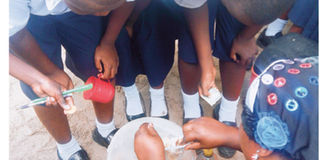When children have to buy snacks from street vendors

Pupils buying snacks from vendors. PHOTO I ESTHER KIBAKAYA
What you need to know:
There, a group of women and young men are visible, sitting in a short line with stools in front of the kids. They carry trays full of snacks and gallons of water.
It is time for the break at Kibangu primary school, when a number of pupils can be seen rushing to the school compound, few meters from the school wall. There, a group of women and young men are visible, sitting in a short line with stools in front of the kids. They carry trays full of snacks and gallons of water.
The pupils are swarming to buy the desired food, hungry after their morning classes. All are eager to purchase snacks from the food vendors so they will keep their hunger at bay until school ends.
Mariam Rashid, a standard four pupil at Kibangu primary school, is one of the many pupils walking out of the school gate. She holds a wrapped piece of sweet fried banana.
“I bought this for one hundred shillings. It’s sweet and I hope it will keep my stomach full until I get home.” explains Mariam.
Like many of her class mates, she depends on the snacks the food vendors sell during break to sustain herself.
“I love Samosa and mangoes, because they are cheap and sweet. My mother can afford to give me 500 per day, but sometimes it’s less than that,” Mariam says. “It is enough, even though sometimes I wish she would give me more. Then I could buy chips like some of my friends do.”
Mariam is a typical example of the many school children in primary school within the city who consume food from street vendors during their break and after class hours.
According to one of the teachers in Kibangu - who wished to remain anonymous - the school has allowed the food vendors to sell their good, so the pupils will have something to eat while they are on break.
“We are very cautious when it comes to these children’s health. So we do not allow just anyone to come and sell whatever they like inside the school”, she explains. “We allow things like snacks and packed juices. And we make sure that if it’s something to be eaten, it is hot.“
Whatever the children eat, it will help to keep up their energy during school hours, before they can go home and eat proper food, the teacher explains.
However, Success noted a number of pupils who bought their food outside the school compound, during but also after school hours.
In Buguruni Chama for instance, Success came across pupils who bought food that the vendors had not covered well.
One of those pupils is eleven-year-old Juma Hassan, a standard 4 pupil from Vingunguti primary school. He says he enjoys buying food from outside the school compound – even though his teachers keep telling the children to avoid that kind of food, as it might make them sick.
“I love buying Kachori and kebab and fried cassava” says Juma. “They are sweet. My friends and I always make sure we have money to buy these things.” He admits that they sometimes buy snacks like that even when they are cold and haven’t been covered.
“Sometimes we find them not covered, but we have never gotten sick from eating them”, Juma says. “Mother always tells me to be careful and not to eat dirty things. Even in school the teachers say the same thing. But we buy whatever our money affords us.”
A number of public primary school don’t have any programs for feeding the students. Particularly in schools located in town the pupil’s nourishment is limited to porridge, which is usually served mid-morning. The case lies different when it comes to private schools, where the pupils are offered food.
According to January Kayombo, a teacher from Liberman Pre and Primary school, the children’s health benefits from proper food as it provides key nutrients they need.
“It’s important for children to eat a healthy food, lunch in particular, as it provides one-third of their daily calories. Compared to children who eat an unhealthy lunch – or none at all, of course – children nourished by a healthy mid-day meal have a higher nutrient intake. This is not true only when it comes to lunch but for the entire daily intake” January Kayombo explains. “A healthy meal includes a children’s daily need of protein, vitamins A and C, iron as well calcium - critical nutrients that otherwise often lack in the children’s diet.”
It becomes harder for the children to concentrate and to muster the energy for after school activities if they aren’t fed something healthy, he adds.
“They’re also more likely to reach for unhealthy snacks later in the afternoon. If they would be fed something healthy at lunch, they would have enough energy to get them If they get a them through the afternoon,” January says.
“It is very unfortunate that many public primary schools don’t have a feeding program. Still, it would be better if parents could afford to pack something for their kid to eat at school. Then, the children would not risk their well-being by consuming the unhealthy food sold on the street.”
Imelda Mbogo, is one of the parents whose child attends a primary school here in Dar es Salaam. As many other parents, she always makes sure that her twelve-year daughter old does not lack some money for school. According to her, she cannot afford to let her kid go to school penniless, as she believes that the money will help during school hours.
“I always make sure I give her some cash to buy snacks in school”, Imelda says. “However, I do my best to remind her not to buy cold food, or to drink water just from anywhere. Additionally, I always pack a bottle of boiled water for her. This at least it is something we can easily afford,” she explains.
Many Tanzanian children are going to school hungry, and sometimes remain hungry throughout the day, particularly in areas with high poverty. To fight this problem, a number of initiatives from both governmental and Non-governmental institution have been called to life, aimed to make sure that school feeding programs get established.
One example of such an initiative comes from the US through the United States Agency for International Development in partnership with the World Food Program. For a year, they have been supporting Tanzanian school feeding programs in the drought prone districts of Arusha, Manyara, Dodoma as well as the Singida region. There, 400’000 children in 600 primary schools have been provided with two meals a day.
The Food for Education program has been administered by the US Department of Agriculture.
This program complements the nearly $9 million dedicated for food assistance in Tanzania that the American people called into action under the Food for Progress Program in 2010, benefitting more than 1.5 million Tanzanians.




